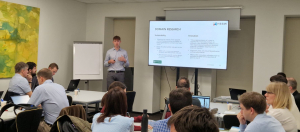LAURA CASTRO
XYZ Specialist
Lorem ipsum dolor sit amet, consectetuer adipiscing elit, sed diam nonummy nibh euismod tincidunt ut laoreet dolore magna aliquam erat volutpat. Ut wisi enim ad minim veniam, quis nostrud exerci tation
-
HOME
-
WORK
-
BATTERY TECHNOLOGIES
-
CIRCULAR ECONOMY
-
DIGITAL MANUFACTURING TOOLS
-
ELECTRIC DRIVES
-
HYDROGEN SYSTEMS
-
MANUFACTURING STRATEGY
-
MANUFACTURING ENGINEERING
-
SUPPLY CHAIN & LOGISTICS
-
LEAN MANUFACTURING & AUTOMATION
-
INSIGHTS
-
BLOGPOSTS
-
REPORTS
-
CASE STUDIES
-
COMPANY NEWS
-
EVENTS
-
TEAM
-
CAREERS
-
CONTACT
-
REQUEST A DEMO

CASE STUDIES
A Strategy to Scale Up Towards a Gigafactory for AMTE Power
/0 Comments/in Uncategorized /by Emily Laver
Leading battery cell manufacturer AMTE Power (AMTE) is moving ahead with plans to develop one of the UK’s first Gigafactories – building its output of critical battery capacity that will underpin the transition to net zero.
The company is using its existing manufacturing base at Thurso, Scotland, to meet increased demand for its new, differentiated products across the automotive and energy storage sectors, while also progressing plans to industrialise its output through a new Gigafactory that will scale up to 10GWh of production.
With the benefit of its existing Thurso base, AMTE teamed up with HSSMI to optimise its manufacturing model. Drawing on lean manufacturing principles, HSSMI assessed AMTE’s current capacity, pinpointed higher impact opportunities to unlock volume production at Thurso, and worked to prototype how this modelling can support even higher volume at Gigafactory production rates.
HSSMI’s work has coincided with major milestones in AMTE’s work at the UK Battery Industrialisation Centre (UKBIC) where it is moving ahead with certification processes that will support high volume production of specialist cells.
Assessing Existing Capability
HSSMI carried out a manufacturing audit of AMTE Power’s Thurso facility with the aim of evaluating the capability of the equipment, the available capacity of the facility (units/annum), and where any bottlenecks might exist.
This was achieved through site visits, meetings with operators, and through gathering equipment data. By quantifying the capability of each process in the cell manufacturing line, it was then possible to visualise and identify potential limitations to production capability. The advice was to address these in order to unlock higher production volumes.
By understanding the capability of each machine and process, it was possible for HSSMI to generate a manufacturing and economic roadmap to achieve higher production volumes at the Thurso facility. This included different economic pathways to increase production volumes, driven by increased shifts and strategic equipment investment.
Implementing Lean Manufacturing Principles to Boost Production Volumes
HSSMI additionally identified practices and principles that the Thurso facility could implement that are more representative of higher volume facilities. This included assessing the current layout of the facility, operator manning, and the use of digital tools for training.
HSSMI designed an improved factory layout to boost operator performance and optimised work instructions to reflect those found in high volume battery manufacturing facilities. The exercise was carried out with the view that these principles could be implemented and refined in the Thurso facility and then be translated to AMTE Power’s future Gigafactory.
A Flexible Model to Understand Manufacturing Capacity
HSSMI created a robust, flexible manufacturing and economic model, which can be used to explore ways to boost production and predict the associated costs. The model presents a clear trade-off between capex and opex costs for different scenarios. Furthermore, thanks to the model, AMTE was able to understand its full manufacturing capability, considering all equipment and processes. AMTE is now able to to work on evolving its production process to achieve maximum efficiency and meet demand for its products.
One of the main findings of the project was that the increased manufacturing capability could be achieved by optimised use of existing assets. Any additional capital investment can be targeted strategically for the maximum step change in production output by unlocking the rate limiting step. This was identified in an investment roadmap where a clear pathway for equipment and shift patterns for a target production capacity was shown.
The aim of this model was to ensure the value generated in the project was long-lasting and it can now be used in the future by AMTE to support key decisions on future planning.
This work was carried out as part of Thurso+, which was a collaborative project between AMTE Power and HSSMI, carried out with funding from Innovate UK and the Automotive Transformation Fund (ATF).
CONTACT US
Contact us today for a short initial conversation on how HSSMI can help your organisation achieve its strategic goals.





















































































































































































